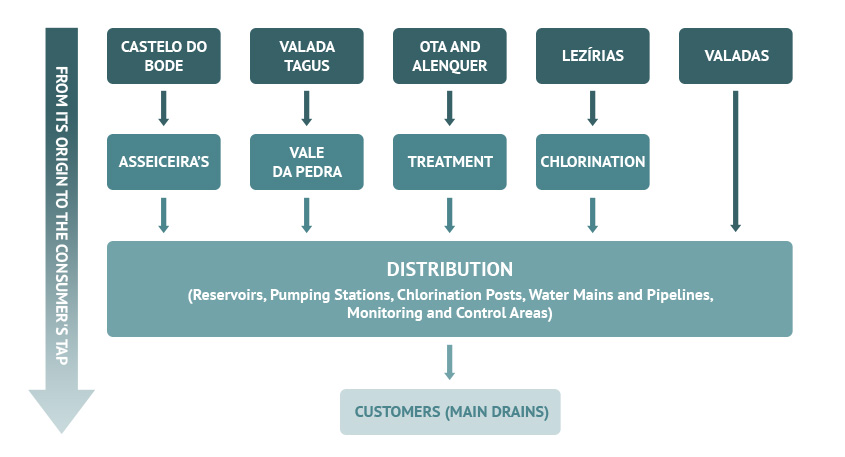EPAL - following its concern with a continuous process, system, and technology improvement - implemented at the end of 2007 a Water Safety Plan in its Supply System, which complies with the methodologies established by the World Health Organisation (WHO) within a perspective of risk analysis and prevention in water supply systems.
“The most effective means of consistently ensuring the safety of a drinking-water supply is through the use of a comprehensive risk assessment and risk management approach that encompasses all steps in water supply from catchment to consumer” (WHO, 2004)
In February 2010, the Board of Directors approved the first edition of EPAL's WSP, which has since become an essential tool in risk analysis, prevention, and management within EPAL's supply system.
The implemented WSP has taken into consideration the entire EPAL's supply system, from the water basins/areas with its origins used by the company for producing water for human consumption up to the end consumer taps (origins, intake, treatment, distribution, and customer main drains) having also been included in the company's risk management.
Flowchart of EPAL's Supply System

The company's WSP
aims at ensuring the requirements for
water quality and quantity for human consumption within EPAL's supply system, hence identifying the Operational Good Practices and Preventive Measures to be implemented based on the identification of hazards and risk analysis and mitigation through:
- Consumer health protection
- Compliance with WHO recommendations and regal requirements
- Increase in consumer satisfaction and trust by improving service quality, particularly in regard to pressure and the physical and organoleptic characters of supplied water (aesthetics, colour, smell, and taste)
- Undisturbed supply
Cycle for WSP implementation and revision at EPAL
1. Planning - Defining goals
- Constituting a team
- Defining methodologies

2. Characterisation of the System - Description of water origins
- Asset identification
- Description of treatment processes
- Description of the distribution network

3. Risk Evaluation - Hazard identification
- Evaluation and validation of control measures / corrective measures (consequences and vulnerabilities)
- Risk evaluation and priority

4. Monitoring

5. Management and Communication - Preparing management procedures
- Development of support programs
- Development, implementation, and management of improvement plans
|  |
EPAL was the first water company to consider the concept of 'quantity' rather than 'quality' in its WSP. The developed WSP took into consideration all parts of its supply system, particularly the water basins, origins, intake, treatment processes, distribution assets (water mains, reservoirs, chlorination posts, pumping stations, pipelines, etc.) and the main drains up to the final use/tap, although EPAL is not directly responsible for the management of some of these components, which is the case of the Water Origins (all upstream reservoirs of their intake and related baseflow) and the Main Drains (up to the consumer's tap).
EPAL's experience in this field shall enable the support of water supply system managing bodies in implementing and/or developing the Water Safety Plan, hence contributing towards a totally safe water quality management that will protect consumers.
Contacts
EPAL – Empresa Portuguesa das Águas Livres, S.A.
Water Quality Control and Laboratories Department
Av. de Berlim, 15
1800-031 Lisbon
Manager | Rui Neves Carneiro
Telephone | +351 218 552 700
Fax | +351 218 552 724